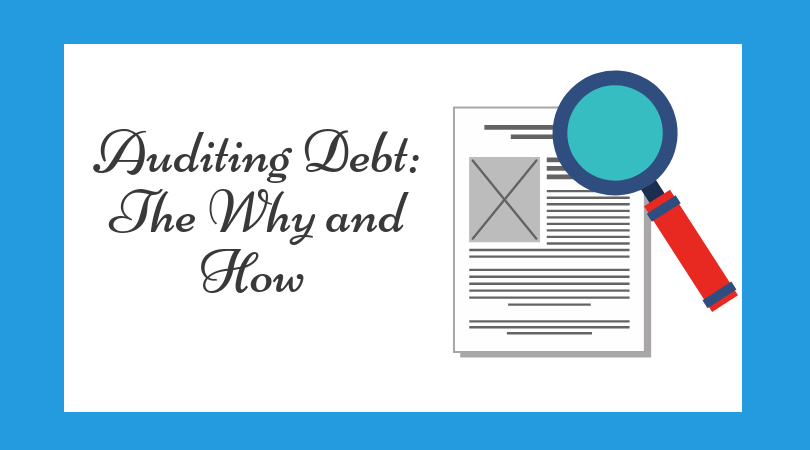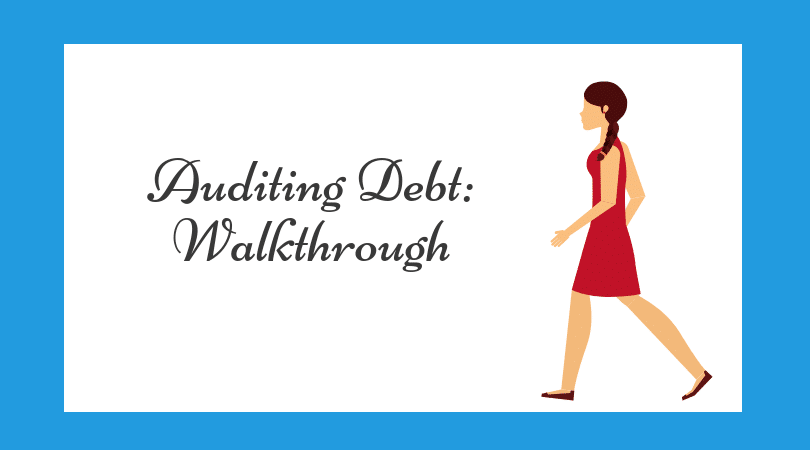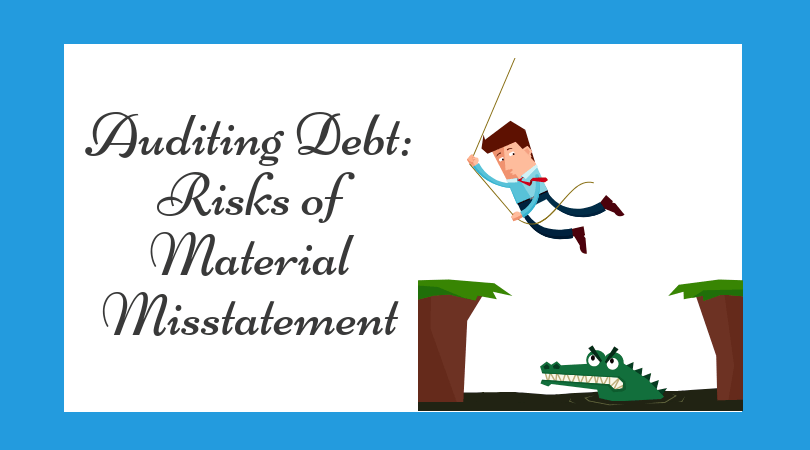
Auditing Debt: The Why and How Guide
By Charles Hall | Auditing
What are the keys to auditing debt?
While auditing debt can be simple, sometimes it’s tricky. For instance, classification issues can arise when debt covenant violations occur. Should the debt be classified as current or noncurrent? Likewise, some forms of debt (with detachable warrants) have equity characteristics, again leading to classification issues. Is it debt or equity—or both? Additionally, leases can create debt, even if that is not the intent.
Most of the time, however, auditing debt is simple. A company borrows money. An amortization schedule is created. And thereafter, debt service payments are made and recorded.
Either way, whether complicated or simple, below I show you how to audit debt.
Auditing Debt — An Overview
In many governments, nonprofits, and small businesses, debt is a significant part of total liabilities. Consequently, it is often a significant transaction area.
In this post, we will cover the following:
- Primary debt assertions
- Debt walkthroughs
- Debt-related fraud
- Debt mistakes
- Directional risk for debt
- Primary risks for debt
- Common debt control deficiencies
- Risk of material misstatement for debt
- Substantive procedures for debt
- Common debt work papers
Primary Debt Assertions
The primary relevant debt assertions include:
- Completeness
- Classification
- Obligation
I believe, in general, completeness and classification are the most important debt assertions. When a company shows debt on its balance sheet, it is asserting that it is complete and classified correctly. By classification, I mean it is properly displayed as either short-term or long-term. I also mean the instrument is debt and recorded as such (and not equity). By obligation, I mean the debt is legally owed by the company and not another entity.
Keep these three assertions in mind as you perform your transaction cycle walkthroughs.
Debt Walkthroughs
Early in your audit, perform a walkthrough of debt to see if there are any control weaknesses. As you perform this risk assessment procedure, what questions should you ask? What should you observe? What documents should you inspect? Here are a few suggestions.
As you perform your debt walkthrough ask or perform the following:
- Are there any debt covenant violations?
- If the company has violations, is the debt classified appropriately (usually current)?
- Is someone reconciling the debt in the general ledger to a loan amortization schedule?
- Inspect amortization schedules.
- Does the company have any unused lines of credit or other credit available?
- Inspect loan documents.
- Has the company refinanced its debt with another institution? Why?
- Who approves the borrowing of new money?
- Who approves new leases? Who handles lease accounting and are they competent?
- Does the company have any leases that should be recorded as debt?
- Inspect new loan and lease approvals.
- How are debt service payments made (e.g., by check or wire)? Who makes those payments?
- Are there any sinking funds? If yes, who is responsible for making deposits and how is this done?
- Observe the segregation of duties for persons:
- Approving new loans,
- Receipting loan proceeds,
- Recording debt in the general ledger, and
- Reconciling the debt in the general ledger to the loan amortization schedules
- Is the company required to file periodic (e.g., quarterly) reports with the lender? Inspect sample debt-related reports, if applicable.
- Does the company have any convertible debt or debt with detachable warrants? Are they properly recorded?
- Is the company following reporting framework requirements (e.g., FASB Codification) for debt?
- Has collateral been pledged? If yes, what?
- What are the terms of the debt agreements?
- Has all debt of the company been recorded in the general ledger?
- Have debt issuance costs been accounted for properly based on the reporting framework requirements? (FASB requires the netting of such costs with debt.)
- Has the company guaranteed the debt of another entity?
If control weaknesses exist, create audit procedures to address them. For example, if—during the walkthrough—we see that one person approves loans, deposits loan proceeds, and records the related debt, then we will perform fraud-related substantive procedures.
Debt-Related Fraud
A company can fraudulently inflate its equity by intentionally omitting debt from its balance sheet. (Total assets equal liabilities plus equity. Therefore, if debt is not reported, equity increases.)
As we saw with Enron, some entities place their debt on another company’s balance sheet. (Enron did so using special purpose entities.) So auditors need to consider that companies can intentionally omit debt from their balance sheets.
Another potential fraudulent presentation is showing short-term debt as long-term. When might this happen? When debt covenant violations occur. Such violations can trigger a requirement to classify the debt as current. If accounting personnel are aware of the requirement to classify debt as current and don’t do so, then the reporting can be considered fraudulent.
Additionally, mistakes can lead to errors in debt accounting.
Debt Mistakes
Errors in accounting for debt can occur when debt service payments are misclassified as expenses rather than a reduction of debt. Also, debt can—in error—be presented as long-term when it is current. Why? Maybe the company’s accountant doesn’t understand the accounting rules.
Some forms of debt, such as leases, can be difficult to interpret. Consequently, a company might errantly fail to record debt when required.
So, what is the directional risk for debt? An overstatement or an understatement?
Directional Risk for Debt
The directional risk for debt is an understatement. So, audit for completeness (and determine that all debt is recorded).
Primary Risks for Debt
Primary risks for debt include:
- Debt is intentionally understated (or omitted)
- Debt is recorded as noncurrent (due more than one year from the balance sheet date) though the amount is current (due within one year of the balance sheet date)
It’s obvious why a company might want to understate its debt. The company looks healthier. But why would a business desire to classify current debt as noncurrent? For the same reason: to make the company look stronger. By recording current debt as noncurrent, the company’s working capital ratio (current assets divided by current liabilities) improves.
As you think about the above risks, consider the control deficiencies that allow debt misstatements.
Common Debt Control Deficiencies
In smaller entities, it is common to have the following control deficiencies:
- One person performs two or more of the following:
- Approves the borrowing of new funds,
- Enters the new debt in the accounting system,
- Deposits funds from the debt issuance
- Funds are borrowed without appropriate approval
- Debt postings are not agreed to amortization schedules
- Accounting personnel don’t understand the accounting standards for debt (including lease accounting)
Another key to auditing debt is understanding the risks of material misstatement.
Risk of Material Misstatement for Debt
In auditing debt, the assertions that concern me the most are classification, completeness, and obligation. So my risk of material misstatement for these assertions is usually moderate to high.
My response to the higher risk assessments is to perform certain substantive procedures: namely, a review of debt covenant compliance and a review of debt and lease agreements—and the related accounting. Why?
As we saw above, debt covenant violations may require the company to reclassify debt from noncurrent to current. Doing so can be significant. The loan could be called by the lender, depending on the loan agreement. So, proper classification of debt can be critical.
Also, some leases should be recorded as debt. If such leases are not recorded, the company looks healthier than it is. Our audit should include procedures that address the completeness of debt and the obligations of the company.
Once your risk assessment is complete, decide what substantive procedures to perform.
Substantive Procedures for Debt
My customary tests for auditing debt are as follows:
- Summarize and test debt covenants
- Review new leases to determine if debt should be recorded
- Confirm all significant debt with lenders
- Determine if all debt is classified appropriately (as current or noncurrent)
- Agree the end-of-period balances in the general ledger to the amortization schedules
- Agree future debt service payment summaries to amortization schedules
- Review accruals of any significant interest
- Review interest expense (usually comparing current and prior year interest)
In light of my risk assessment and substantive procedures, what debt work papers do I normally include in my audit files?
Common Debt Work Papers
My debt work papers normally include the following:
- An understanding of debt-related internal controls
- Documentation of any internal control deficiencies related to debt
- Risk assessment of debt at the assertion level
- Debt audit program
- A copy of all significant debt agreements (including lease and line-of-credit agreements)
- Minutes reflecting the approval of new debt
- A summary of debt activity (beginning balance plus new debt minus principal payments and ending balance)
- Amortization schedules for each debt
- Summary of all debt information for disclosure purposes (e.g., future debt service to be paid, interest rates, types of debt, collateral, etc.)
If there are questions regarding debt agreements and their presentation, I include additional language in the representation letter to address the issues. For example, if an owner loans funds to the company but there is no written debt agreement, the owner or management might verbally explain the arrangement. In such cases, I include language in the management representation letter to cover the verbal responses.
In Summary
In this article we’ve looked at the keys to auditing debt. Those keys include risk assessment procedures, determining relevant assertions, creating risk assessments, and developing substantive procedures. The most important issues to address are usually (1) the classification of debt (especially if debt covenant violations exist) and (2) lease accounting.
To understand the new lease standard (ASC 842) from the lessee’s perspective, see my lease article: Account for Finance and Operating Leases.
Next we’ll look at how to audit equity.





